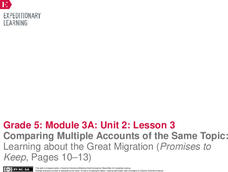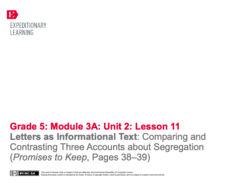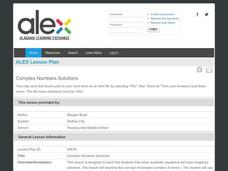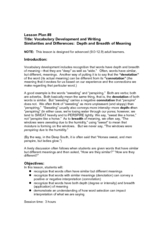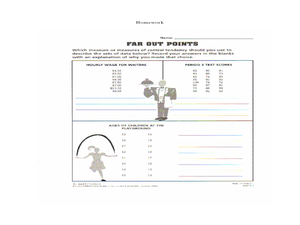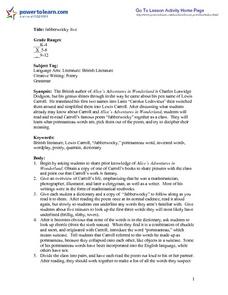EngageNY
Comparing Multiple Accounts of the Same Topic: The Story of Bus Desegregation (Promises to Keep, Page 21)
It's all connected. Learners read event details in Promises to Keep to determine the connection between the bus boycott and Jackie Robinson. They watch a video and read Rules for Riding Desegregated Buses to discover even more details to...
EngageNY
Comparing Multiple Accounts of the Same Topic: Learning about the Great Migration (Promises to Keep, Pages 10–13)
Get the story straight. Scholars gather information about the Great Migration as they listen to a reading from Promises to Keep. They then examine the text to find evidence to support the feeling of resentment. Learners take part in a...
EngageNY
Letters as Informational Text: Comparing and Contrasting Three Accounts about Segregation (Promises to Keep, Pages 38–39)
Letters ... a lost art or good resource? Scholars add letter writing to their informational text chart and describe the features of a letter. They then look at page 38 in Promises to Keep and complete a Perspectives Venn diagram. To...
EngageNY
Mid-Unit Assessment: Text-Dependent and Short Answer Questions: “Arctic Fun”
Let's have a little fun! Readers take a mid-unit assessment by answering text-dependent and short-answer questions using the text Arctic Fun. They then complete a form to track their progress in the unit thus far.
EngageNY
Synthesizing Text Details to Explain Relationships: “Medicine and Healing”
After reading the section about medicine and healing in The Inuit Thought of It, leaners determine what they feel was the most important resource to surviving in the Arctic environment. They support their opinions with details from the...
EngageNY
Margin of Error When Estimating a Population Proportion (part 2)
Error does not mean something went wrong! Learners complete a problem from beginning to end using concepts developed throughout the last five lessons. They begin with a set of data, determine a population proportion, analyze their result...
Alabama Learning Exchange
Complex Numbers Solutions
Complex doesn't have to mean harder! Learners experiment with online software to determine the quadratic equations with complex solutions. They use the quadratic formula to solve equations with both real and complex solutions.
EngageNY
Interviewing Meg Lowman: What Does it Mean to be a Responsible Scientist? (Pages 37–39)
Can I ask you something? Scholars read about the night walk on pages 37-39 of The Most Beautiful Roof in the World. After discussing the text with their group, they work together to create interview questions they would ask Meg Lowman....
Curated OER
Concrete Poems
Concrete poems, or shape poems as they are sometimes called, are the focus of the eighth instructional activity in this poetry unit. Young scholars examine several examples of concrete poems and consider how the shape contributes to the...
Curated OER
Introduce: The Suffix -ing
Second and third graders are introduced to the suffix ing and examine a list of words with the suffix. They examine the meaning of the target suffix as it relates to the present verb tense and connect suffix ing words with prior...
Curated OER
Vocabulary Development and Writing
Engage pupils in practicing denotative and connotative strategies to understand particular words. They work in pairs and write a series of sentences using each word that has a positive connotation and negative connotation. Some example...
Curated OER
"Jabberwocky": Inferring
Pupils, over an extended time, read and explain the nonsense words of Lewis Carroll's poem, "Jabberwocky". They infer the meaning of the poem using visualizing as well as decoding skills. While written for first graders, this is easily...
Curated OER
Can You Get the Signal?
What is a signal word? Recognizing these words is an important step in both reading and writing formal text. Review a list of signal words (provided and organized into specific categories), and then have your class play a game to...
Curated OER
Baseball Vocabulary Game: ESL Beginners
The most valuable part of this lesson is the instructions to "Vocabulary Baseball," which can be applied to any vocabulary or key terms list. The game uses word boxes and the autobiography of Roberto Clemente, which the lesson describes...
Curated OER
China's Population Growth
Learners collect data from China's population growth and determine the mean, median, and mode from the data. In this data lesson plan, pupils determine probabilities and use them to make predictions.
Curated OER
Vowel Sounds
This plan aims to increase the reading proficiency of your fourth grade class. While no materials are provided, a list of activities to practice are included. Various activities include creating songs for short vowel sounds, using cue...
Curated OER
Gary Paulsen's Canyons: Vocabulary Activity
The final chapters of Canyons (chapters 17-24) present readers with more challenging vocabulary. Two activities provide readers with an opportunity to figure out what they know, and then to use what they know to complete a word search...
Curated OER
"Jabberwocky" Jive
Pupils review the fantasy of Alice in Wonderland and discuss the author. After reading the poem, "Jabberwocky," they look up unfamiliar words in the dictionary. Working as partners, they create a list of "protmanteau" or invented words...
Curated OER
Usage Errors
Look at the most commonly confused words in the English language! This resource briefly explains the difference between there, they're, and their as well as too, to, and two, and finally it's and its. First, read the section entitled...
Curated OER
Introduce Vocabulary: Kindergarten ABC
Students explore vocabulary words. In this language arts lesson, students listen to the story Kindergarten ABC and discuss the vocabulary words. Students discuss the word meanings and use the word in context.
Curated OER
Word Structure
Young scholars infer the meanings of unfamiliar words using context clues and knowledge of prefixes and suffixes. They identify vocabulary words as nouns or adjectives using context clues and suffixes. In addition, they decide the...
Curated OER
How New Words are Created
Young scholars complete a matching activity, matching words with "method of formation." In this language arts activity, students complete sentences using rhyming pairs, break down words into 2, and complete a creative exercise, blending...
Curated OER
Introduce Vocabulary: Cows Can't Fly
Students are introduced to vocabulary words from the story Cows Can't Fly and identify words during the reading of the story. In this introduction to vocabulary words lesson, students recall vocabulary words from the story and then use...
Curated OER
Compound-Go-Round
Students make compound words by putting together cards with whole words on them. In this language arts lesson plan, students play a game where they match up words in an attempt to make compound words that make sense. A fun, meaningful...
Other popular searches
- Multiple Word Meanings
- Word Meanings in Context
- Foreign Word Meanings
- Word Meanings From Context
- Similar Word Meanings
- Clarify Word Meanings
- Vocabulary. Word Meanings
- Word Meanings Lesson Plans
- Glossary Word Meanings
- Meanings of Word Parts
- Word Meanings/definitions
- Multiple Word Meanings 4th



